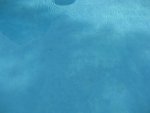- Jun 8, 2009
- 20
this pool was replastered March 2008 with Diamond Brite super blue batch tx121707507 by an authorized applicator. last year I started seeing grey spots on the shallow end floor. the spot sizes vary but are typically approximately 2 inches in diameter. they disappear/reappear daily not in relation to any time of day, sunlight or water temperature and are not stationary (different location and number when they reappear.) last year I had emailed these photos to SGM tech support in Florida who had no suggestion or thought to resolve.
this year the spots are increasing in number and also starting to appear in the deep end. I understand SGM had warranty issues with other Diamond Brite pools in this area (Louisiana) but there doesn't seem to be any information that could relate to my situation,
I had the applicator inspect and he suggested acid wash without any explanation as to cause.
I tested for metals using Hach test strips. no metals. plumbing is all plastic, no heater.
chemistry:
TH 250
TC 4
FC 7
ph 7.2
TA 80
CYA 50
municipal water. this area has quite a few chemical plants. with that in mind, I'm thinking about dumping water and refilling.
any ideas or suggestions?
this year the spots are increasing in number and also starting to appear in the deep end. I understand SGM had warranty issues with other Diamond Brite pools in this area (Louisiana) but there doesn't seem to be any information that could relate to my situation,
I had the applicator inspect and he suggested acid wash without any explanation as to cause.
I tested for metals using Hach test strips. no metals. plumbing is all plastic, no heater.
chemistry:
TH 250
TC 4
FC 7
ph 7.2
TA 80
CYA 50
municipal water. this area has quite a few chemical plants. with that in mind, I'm thinking about dumping water and refilling.
any ideas or suggestions?



